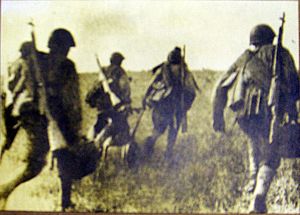
Back معركة لينينو Arabic Бітва пад Леніна Byelorussian Бітва пад Ленінам BE-X-OLD Lahing Lenina all Estonian Bataille de Lenino French Bitwa pod Lenino Polish Битва под Ленино Russian ยุทธการที่เลนิโน Thai Битва під Леніно Ukrainian Trận Lenino Vietnamese
| Battle of Lenino | |||||||||
|---|---|---|---|---|---|---|---|---|---|
| Part of the Eastern Front of World War II | |||||||||
 Troops of the Polish 1st Tadeusz Kościuszko Infantry Division at the Battle of Lenino. | |||||||||
| |||||||||
| Belligerents | |||||||||
|
|
| ||||||||
| Commanders and leaders | |||||||||
|
|
| ||||||||
| Units involved | |||||||||
|
33rd Soviet Army Polish 1st Tadeusz Kościuszko Infantry Division | |||||||||
| Casualties and losses | |||||||||
| c. 1800[citation needed] | c. 3000[citation needed] | ||||||||
| See section on casualties for further details. | |||||||||
The Battle of Lenino was a tactical World War II engagement that took place on 12 and 13 October 1943, north of the village of Lenino in the Mogilev region of Byelorussia. The battle itself was a part of a larger Soviet Spas-Demensk offensive operation with the aims of clearing the eastern bank of the Dnieper River of German forces and piercing the Panther-Wotan line of defences. The battle is prominent in Polish military history, as it was one of the first major engagements of Polish Armed Forces in the East.
While the Polish and Soviet forces managed to break through the German defences and inflict heavy casualties on the Germans, they were unable to keep the advance. There was a failure in cooperation from other Red Army units, and a lack of artillery support or close air cover caused by the ongoing Wehrmacht panzer counter-attack against the 10th Guards Army to the north of the 33rd Army. The division was forced to assume defensive positions, and was ordered to hold its ground due to the expected arrival in its sector of the 6th Guards Cavalry Corps, which was tasked with breaking through the German defensive position.
The relief never arrived; after two days the Polish 1st Tadeusz Kościuszko Infantry Division suffered 25% casualties and had to be withdrawn, while the remaining Soviet forces were too weak to widen the achieved breakthrough.